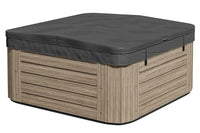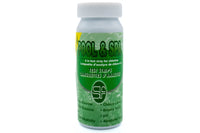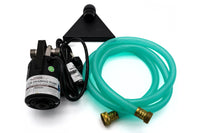Foam can be fun in a bubble bath, but it’s often an alarming sight in a hot tub. For that reason, it’s a topic that rears its head frequently among hot tub owners. If you browse the backlog of hot tub forums online, you'll find countless people asking, "Why is my hot tub foaming?" "What causes hot tub foam?, and "Is hot tub foam dangerous?”.
This article aims to cut through the noise, explain why foam happens, and offer actionable advice for spa owners aiming to correct or prevent the nuisance in the future.
Together, let’s kick the foam so you can get back to relaxing in the tub.
What Causes Foam in Hot Tubs?
Several factors can contribute to hot tub foam. Understanding what’s causing your hot tub to foam requires you to don your detective’s hat and check for a few common culprits. This section covers the usual suspects responsible for foaming in most to all cases that we've experienced.
Water Contaminants
Water contaminants are perhaps the leading culprit of foam. These contaminants include:
- Body products like sunscreen, moisturizer, and soap residue
- Laundry detergent residue in bathing suits
- Makeup
- Sweat
- Biofilms (thin layers of bacteria that can form on hot tub surfaces)
- Backyard debris like leaves, dirt, and bugs
- And even drink or food spillage
These contaminants cause foam in a number of ways: They alter the water’s surface tension, introduce surfactants that make it easier for bubbles to form, and bind with water minerals to create a soapy effect.
Water Chemistry Issues
Even hot tub owners fastidious about limiting water contaminants might notice cloudy water and foaming. Why’s that? Well, water chemistry problems are another common offender for hot tub foam.
For instance, imbalanced pH levels can lead to foam because they affect the water's overall chemistry and the effectiveness of sanitizers; high pH reduces the effectiveness of chlorine (and, to a much lesser extent, bromine), allowing contaminants to accumulate and foam. Likewise, low calcium can decrease the water’s surface tension, setting the stage for foam.
Below, in our “How to Get Rid of Hot Tub Foam” section, we’ll post a few benchmark ranges for ideal water chemistry.
Low-Quality Chemicals
Some articles suggest that using low-quality chemicals can lead to hot tub foam. We’ve yet to see an authoritative, research-backed source to bolster this claim, but it seems reasonable.
Low-quality chemicals or chemicals not specifically designed for hot tubs will do an inferior job balancing your hot tub chemistry (obviously). And as we detail directly above, imbalanced water chemistry results in foam.
While this cause might be anecdotal, it’s still best practice to use the highest quality hot tub chemicals you can find. The Cover Guy has a curated range of balancers, sanitizers, and weekly maintenance products that are tried-and-tested winners.
Clogged Filters
Your hot tub filter works tirelessly to trap contaminants and effectively remove them from circulation. If that filter clogs, all of those contaminants get a free pass to upset your hot tub’s balance and create foam.
If you’re experiencing continual foam, even after you’ve corrected for contaminants and water chemistry, your filter might be the culprit. Rinse it twice weekly with a garden hose, and consider regularly cleaning your filter overnight in a solution designed for hot tub filters.
Alternatively, you may need to replace your filter to start seeing that crystal-clear water again.
Jet Agitation
Finally, hot tub foam is also the result of a normal physical reaction—jet agitation. In a well-balanced, contaminant-light tub, that agitation creates clear, twinkling bubbles that add to the overall magic of the hot tub experience. That agitation turns ugly when things are amiss.
Imagine shaking a bottle of pure water; the vigorous agitation causes some small bubbles, but they dissipate quickly. Now, imagine shaking a bottle of water to which you’ve added some soap, a little oil, a drop of sunscreen, a dash of baking soda, etc. The intense agitation will form a lasting froth at the top of the bottle.
How to Get Rid of Hot Tub Foam and Prevent it from Returning
Now that you know the causes of this unsightly buildup, let’s clear the air a bit. Hot tub foam is not dangerous, per se. It’s unsettling, maybe even a bit gross, but it is not dangerous in and of itself. However, the underlying causes of hot tub foam—imbalanced water chemistry, increased contaminants, defective filters—can cause irritation and bacterial buildup.
Therefore, interpret foam as a sign from your hot tub to take action. Here are a few ways to get rid of hot tub foam and prevent it from returning.
Perform Routine Water Testing and Chemical Maintenance
This is your best bet for addressing hot tub foam. Routinely test and balance your tub’s pH, alkalinity, calcium hardness and sanitization to maintain an ecosystem equipped to handle contaminants. Here are a few ranges to reach for:
- A pH level between 2 to 7.8
- Calcium hardness between 150-250 parts per million (ppm)
- Alkalinity between 80 – 120 ppm
- The recommended amount of bromine or chlorine sanitizer and weekly maintenance products, as outlined on the product label.
Keeping these figures consistently within range allows your spa to combat water foam. It also improves your enjoyment and extends the longevity of your investment. For a hands-off approach to sanitization, check out the Floating Puck Dispenser, which floats in the tub and continuously releases sanitizer to keep the water clean and clear.
Deep Clean Your Spa
If regular maintenance hasn’t been a feature of your hot tub routine to date, you may need to start with a deep clean to remove stubborn, foam-causing residues.
In our popular resource on deep cleaning your hot tub, The Cover Guy details all the steps to take. In the link to the left, learn how to drain the tub, wipe the shell, and thoroughly clean the filter for a cleaner spa experience. If you need extra help draining your hot tub, visit this link.
Use a Hot Tub Defoamer
Hot tub defoamer is a silver bullet solution for one-time foam elimination. Yes, it works to break up the foam and get that unsightly stuff away for a quick fix. However, it doesn’t tackle the root causes listed above. By all means, use a sparing amount of defoamer (ideally, a defoamer that doesn't impact your water chemistry) to tackle the aesthetic issue. But don’t rely on defoamer alone.
Consider a Custom-Made Hot Tub Cover
Hot tub covers are, first and foremost, about protecting your investment from the elements. However, they also feature auxiliary benefits that can help limit foaming. A durable, custom-made hot tub cover will keep out any backyard contaminants like leaves, bugs, rain, dirt, and dust. By limiting these natural contaminants, you can limit the possibility of foam.
If your current cover isn’t up to the job, you can buy a hot tub cover specifically designed for your spa—just click the link to get started!
Shower Before Using the Hot Tub
An easy preventative measure against foam is to shower before using the spa. Make it a policy in your household to clean away any lotions, oils and cosmetics before taking a dip. Obviously, you can waive the rule when you have guests over—you can't control every variable!
Rinse Your Bathing Suits
Lastly, a minor preventative measure is rinsing your bathing suit before sinking into the hot tub. Swimsuits straight out of the washer/dryer will have traces of detergent residue; rinsing them in plain water ensures these residues end up down the drain—not in your tub. This step might not move the needle drastically, but it can help.
By understanding and controlling the underlying causes of hot tub foam, you can create a more picturesque spa experience. More than that, you maintain a spa that’s chemically balanced, light on contaminants, properly looked after, and just overall more enjoyable.










